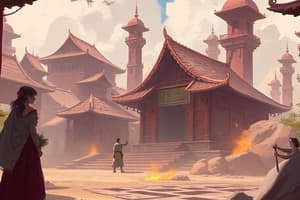Podcast
Questions and Answers
What does the term 'politics' primarily relate to, according to the provided text?
What does the term 'politics' primarily relate to, according to the provided text?
- The use of technology in various enterprises.
- The activities associated with governing an area. (correct)
- The sharing of culture among members of a group.
- The promotion of tourism in a country.
How has the use of technology affected tourism professionals?
How has the use of technology affected tourism professionals?
- It has increased the number of employees needed in tourism.
- It has created more manual tasks.
- It has replaced some of their work with faster systems. (correct)
- It has made their jobs slower and less current.
How is culture primarily conveyed and shared among individuals?
How is culture primarily conveyed and shared among individuals?
- Through the establishment of political systems
- Through visual arts and performance-based activities
- Through economic transactions and trade
- Through language, whether written, spoken, or both (correct)
How is culture primarily learned, according to the text?
How is culture primarily learned, according to the text?
Which of the following is NOT mentioned as an element of culture?
Which of the following is NOT mentioned as an element of culture?
What is the primary function of law within a society?
What is the primary function of law within a society?
According to the provided data, which religious group constitutes the largest percentage in the Philippines?
According to the provided data, which religious group constitutes the largest percentage in the Philippines?
How is culture shared among people?
How is culture shared among people?
What impact does tourism have on social structures within tourist destinations?
What impact does tourism have on social structures within tourist destinations?
What is the significance of shared culture as described in the text?
What is the significance of shared culture as described in the text?
How is culture transmitted, as stated in the text?
How is culture transmitted, as stated in the text?
Besides transmission, what other functions does language have in reference to culture?
Besides transmission, what other functions does language have in reference to culture?
Why is it crucial for professionals to be aware of the laws and politics of their work location?
Why is it crucial for professionals to be aware of the laws and politics of their work location?
Which of the following best describes how a child's cultural understanding expands, according to the text?
Which of the following best describes how a child's cultural understanding expands, according to the text?
What is the percentage of those who identify as Protestant in the Philippines, according to the CIA Factbook?
What is the percentage of those who identify as Protestant in the Philippines, according to the CIA Factbook?
Which of the following best describes the dual role of religion in a society?
Which of the following best describes the dual role of religion in a society?
What is a primary reason why cultural practices may be forgotten?
What is a primary reason why cultural practices may be forgotten?
Which of these factors is LEAST likely to contribute to changes in culture?
Which of these factors is LEAST likely to contribute to changes in culture?
Why is it important for a tourism professional to be aware of cultural variations?
Why is it important for a tourism professional to be aware of cultural variations?
What does it mean when it is said that culture is 'accumulative'?
What does it mean when it is said that culture is 'accumulative'?
What aspect of a cultural practice will most strongly influence the intensity of change it experiences?
What aspect of a cultural practice will most strongly influence the intensity of change it experiences?
If a cultural practice has 'rationale', what is most likely true?
If a cultural practice has 'rationale', what is most likely true?
What situation would be an example of how culture 'is integrated'?
What situation would be an example of how culture 'is integrated'?
Which of these statements best reflects the relationship between cultural groups within a large society?
Which of these statements best reflects the relationship between cultural groups within a large society?
What is a key factor that allows culture to thrive according to the text?
What is a key factor that allows culture to thrive according to the text?
How does observing the behavior of others shape an individual's cultural practices?
How does observing the behavior of others shape an individual's cultural practices?
What can happen if the rationale behind a cultural practice is poorly communicated?
What can happen if the rationale behind a cultural practice is poorly communicated?
What does the text suggest about the importance of continuous transmission of cultural elements?
What does the text suggest about the importance of continuous transmission of cultural elements?
Who is typically the holder of family practices?
Who is typically the holder of family practices?
What can happen if there is no one to ensure the continued practice of cultural elements?
What can happen if there is no one to ensure the continued practice of cultural elements?
What identifies a group of people as coming from a specific region or province according to the text?
What identifies a group of people as coming from a specific region or province according to the text?
How does the text describe special events like Holy Week in relation to cultural practices?
How does the text describe special events like Holy Week in relation to cultural practices?
What is a significant factor influencing the ease or difficulty of handling diversity among peers?
What is a significant factor influencing the ease or difficulty of handling diversity among peers?
What is a key characteristic of the 'global citizen' as described in the text?
What is a key characteristic of the 'global citizen' as described in the text?
Which of the following is NOT mentioned as a rule to follow when your superior is diverse?
Which of the following is NOT mentioned as a rule to follow when your superior is diverse?
What has contributed to the growth of the 'circle of friends'?
What has contributed to the growth of the 'circle of friends'?
Why might handling peer diversity be challenging for a tourism professional?
Why might handling peer diversity be challenging for a tourism professional?
What is the main idea of the section titled ‘Handling multicultural peer diversities’?
What is the main idea of the section titled ‘Handling multicultural peer diversities’?
What is the main concept associated with the recognition and promotion of sociocultural differences within a group or society?
What is the main concept associated with the recognition and promotion of sociocultural differences within a group or society?
According to the chapter on diverse superiors, what does being 'inquisitive' imply?
According to the chapter on diverse superiors, what does being 'inquisitive' imply?
Which of the following is NOT mentioned as a potential cause of misunderstanding in the workplace?
Which of the following is NOT mentioned as a potential cause of misunderstanding in the workplace?
What is the most appropriate approach to interacting with people from different cultures?
What is the most appropriate approach to interacting with people from different cultures?
What is a key message from the text regarding cultural differences?
What is a key message from the text regarding cultural differences?
What does the phrase 'The world is getting smaller' imply in the context of the text?
What does the phrase 'The world is getting smaller' imply in the context of the text?
Which action demonstrates the most effective approach to multiculturalism, as implied in the text?
Which action demonstrates the most effective approach to multiculturalism, as implied in the text?
Flashcards
Culture is Learned
Culture is Learned
The process of acquiring knowledge, values, beliefs, and behaviors from others within a society.
Culture is Shared
Culture is Shared
Culture is shared among members of a community and passed down through generations.
Cultural Transmission
Cultural Transmission
The process of transmitting cultural elements from one generation to the next through interactions, education, and daily practices.
Culture is Social
Culture is Social
Signup and view all the flashcards
What is law?
What is law?
Signup and view all the flashcards
How does language transmit culture?
How does language transmit culture?
Signup and view all the flashcards
What are the roles of religion in society?
What are the roles of religion in society?
Signup and view all the flashcards
What is social organization?
What is social organization?
Signup and view all the flashcards
How do laws and politics affect business?
How do laws and politics affect business?
Signup and view all the flashcards
How does tourism change social organizations?
How does tourism change social organizations?
Signup and view all the flashcards
How does language create cultural expressions?
How does language create cultural expressions?
Signup and view all the flashcards
How is culture transmitted through language?
How is culture transmitted through language?
Signup and view all the flashcards
Rationale for Practice
Rationale for Practice
Signup and view all the flashcards
Interaction and Cultural Appreciation
Interaction and Cultural Appreciation
Signup and view all the flashcards
Influence of Others on Culture
Influence of Others on Culture
Signup and view all the flashcards
Elders as Cultural Keepers
Elders as Cultural Keepers
Signup and view all the flashcards
Cultural Decline
Cultural Decline
Signup and view all the flashcards
Cultural Adaptation
Cultural Adaptation
Signup and view all the flashcards
Regional Cultural Distinctiveness
Regional Cultural Distinctiveness
Signup and view all the flashcards
Multicultural Diversity
Multicultural Diversity
Signup and view all the flashcards
Global Citizen
Global Citizen
Signup and view all the flashcards
The world becoming smaller
The world becoming smaller
Signup and view all the flashcards
Workplace Differences
Workplace Differences
Signup and view all the flashcards
Acknowledge Individual Differences
Acknowledge Individual Differences
Signup and view all the flashcards
Respecting Cultural Differences
Respecting Cultural Differences
Signup and view all the flashcards
Adopting Multicultural Practices
Adopting Multicultural Practices
Signup and view all the flashcards
Learning to be Multicultural
Learning to be Multicultural
Signup and view all the flashcards
Handling Multicultural Peer Diversities
Handling Multicultural Peer Diversities
Signup and view all the flashcards
Become a Walking Wikipedia
Become a Walking Wikipedia
Signup and view all the flashcards
Observe the Basic Rules of Engagement
Observe the Basic Rules of Engagement
Signup and view all the flashcards
Be Yourself in Everything
Be Yourself in Everything
Signup and view all the flashcards
Respect His Diversity
Respect His Diversity
Signup and view all the flashcards
Culture is Changing
Culture is Changing
Signup and view all the flashcards
Culture is Accumulative
Culture is Accumulative
Signup and view all the flashcards
Cultural Practice Intensity
Cultural Practice Intensity
Signup and view all the flashcards
Culture is Integrated
Culture is Integrated
Signup and view all the flashcards
Culture Varies
Culture Varies
Signup and view all the flashcards
Importance of Explanation
Importance of Explanation
Signup and view all the flashcards
The Power of 'Why'
The Power of 'Why'
Signup and view all the flashcards
Tourism and Cultural Awareness
Tourism and Cultural Awareness
Signup and view all the flashcards
Study Notes
Chapter 1: Understanding Culture
- Culture is the learned and socially constructed ways of behaving and believing that identify distinct social groups.
- Culture encompasses beliefs, values, knowledge, assumptions, experiences, ideas, customs, rituals, symbols, myths, legends, social activities, economics, politics, agriculture, industry, laws, justice systems, health, environment, education, and religion.
- Art is an expression of creative ideas and imagination, used to represent a society's development.
Elements of Culture
- Art: Creative expression, including paintings, artifacts, clothing, music, sculptures, dances, plays, literature, architecture.
- Beliefs and Values: Ethical principles, standards, and qualities held in high regard by a person or group, shaped by upbringing and experiences.
- Geography: Natural and man-made physical landscapes.
- Language: Used to communicate culture, impacting transmission and preservation.
- Law and Politics: Laws and political systems within a country impact the workplace.
- Religion: Establishment of moral philosophy affecting a people's beliefs and practices.
- Technology: Modern tools and systems impacting tourism, such as better travel options and communication;
- Social Organization: Community structures like the family, neighborhood, or organizations, impact group behaviors.
Chapter 2: Culture is Learned
- Culture is learned through family interactions and continuous learning from older individuals.
- Children continuously acquire skills and knowledge, and culture is taught through repetition, reminders, and action.
- Cultural transmission can be through practice, written or verbal communication.
- Culture is expressed through shared beliefs, values, arts, language, religion.
Chapter 2: Culture is Shared
- Culture is shared and transmitted to succeeding generations.
- Many elements, such as arts, languages and beliefs, are shared by a given area's people.
- The practice of a culture is often transmitted from older to younger generations.
Chapter 2: Culture is Transmitted
- Culture is transmitted through interaction and practice.
- Culture is transmitted through written or verbal forms.
- The patriarch or matriarch of the family often transmits cultural practices.
Chapter 2: Culture is Accumulative
- Culture constantly changes with time.
- Culture is heavily influenced by interactions with other groups and communities.
- Culture evolves with the involvement of differing individuals and practices.
Chapter 2: Culture is Continuous
- Culture elements are continuously transmitted from one generation to the next.
- This ensures consistent understanding and application of traditions, histories, and origins of a practice.
- Culture's rationale is important for understanding the reasons behind the practice.
Chapter 2: Culture is Integrated
- People are brought together by common values.
- Common practices ease understanding of, and appreciation for, shared culture.
- Culture is uniquely practiced in different communities; similarities and unique features exist between communities and countries.
Chapter 2: Culture is Changing
- Culture evolves due to new technologies, governmental shifts, societal changes, and individual innovations.
Chapter 2: Culture Varies from Society to Society
- Subgroups within societies carry unique perspectives and cultural practices.
- Expect variations in culture in tourism destinations.
- Tourists should be aware of unique cultures and practices.
Chapter 4: Tourism in the Philippines
- Roads have improved in the Philippines, enhancing travel.
- Ferry and Roll-on/Roll-off (RoRo) services have improved accessibility between islands.
- Affordable and efficient transportation options in the Philippines are increasing, including water and air travel.
Culture is Multicultural
- The term "multicultural" is synonymous with culturally diverse, pluralism, diversity, cross-culturalism, ethnic inclusiveness, ethnic mosaic, and multiracialism.
Chapter 4: Impact of Tourism Development
- Locations are no longer limited by location restrictions.
- Technology has widened access to information and travel opportunities.
- Globalization has made accessibility to travel and information easier than it had been in the past.
Chapter 7: Handling Customer Diversity
- Professionalism, effective listening, understanding differences, and flexibility are vital for handling diverse customer needs.
Chapter 7: Handling Peer Diversity
- Teamwork, respect, and understanding help foster productive relationships.
- Peer interactions and engagements can be facilitated with mutual respect.
Chapter 8: Handling Multicultural Peer Diversities
- Peers share a significant amount of time with colleagues.
- Diversity between colleagues can either be very easy to manage or quite challenging.
- The amount of time spent with peers influences interaction, with greater exposure potentially leading to a deeper understanding and acceptance of different perspectives.
Chapter 9: When Your Superior is Diverse
- Respecting superiors' diversity is crucial.
- Understanding superiors' background and perspectives creates a more supportive and effective working environment.
Chapter 3: Primary and Secondary Labor Division with Job Titles
- Lists job titles associated with the hotel and travel industry. Includes possible roles within these departments.
Studying That Suits You
Use AI to generate personalized quizzes and flashcards to suit your learning preferences.




